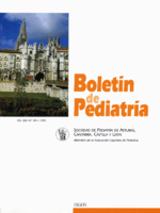Síndrome de West: factores etiológicos
A.C. Rodríguez Dehli , D. Pérez Solís , J. de Juan Frigola , F. Villanueva Gómez , C. García López
Bol. Pediatr. 2003; 43 (183): 13 - 18
Introducción: El síndrome de West (SW) se caracteriza por la presencia de espasmos en salvas, trazado electroencefalográfico hipsarrítmico y detención o regresión en el desarrollo psicomotor. El objetivo de este estudio es conocer la distribución etiológica del SW en nuestro medio y su evolución en el tiempo. Método: Estudio retrospectivo de 20 niños diagnosticados de SW entre 1993 y 2001. Se analizan las causas y se describen los métodos diagnósticos empleados, tratamiento y evolución. Se comparan los resultados con otro estudio realizado entre 1975 y 1986 en el mismo hospital. Resultados: Relación varón:mujer de 1,5:1. La edad media al comenzar los espasmos fue de 7,4 meses (rango 2-14 meses), con una demora hasta el diagnóstico igual o superior al mes en el 60% de los casos. Se identificaron 16 casos sintomáticos (11 de origen prenatal, 4 perinatal y 1 postnatal), 3 criptogénicos y 1 idiopático. La hipsarritmia y los espasmos desaparecieron en todos los pacientes, pero en la mitad de los casos sintomáticos persistieron otros tipos de crisis. Se registraron 3 exitus, todos sintomáticos. La proporción de casos sintomáticos fue significativamente mayor en el período 1993-2001 (16/20, 80%) respecto a 1975-1986 (15/30, 50%). Conclusiones: Las nuevas tecnologías permiten identificar como sintomáticos una mayor proporción de pacientes con SW. Persiste una importante demora en el diagnóstico por la confusión de los ?espasmos? con otros episodios paroxísticos no epilépticos. Ante la sospecha clínica debe practicarse un electroencefalograma con urgencia para confirmar o descartar hipsarritmia. Las lesiones preexistentes condicionan la evolución de los SW sintomáticos. Abstract Introduction:West syndrome (WS) is characterized by spasms in clusters, hypsarrhythmia and developmental stagnation or regression. The objective of this study is to know the etiologic distribution of WS in our area and changes over time. Method: Retrospective study of 20 children with WS diagnosis from 1993 to 2001. Causes are analyzed, and diagnostic methods used, therapy, and progress are described. Results are compared with other study made from 1975 to 1986 in the same hospital. Results: Ratio male: female of 1.5:1. The mean age of beginning of the spasms was 7.4 months, with a diagnosis delay of at least one month in 60% of the patients. 16 symptomatic cases (11 of prenatal origin, 4 perinatal and 1 postnatal), 3 cryptogenic and 1 idiopathic were identified. The hypsarrhythmia and the spasms disappeared in all patients, but half of symptomatic cases persisted with other types of seizures. 3 exitus were recognized, all of them symptomatic. The rate of symptomatic cases was significantly higher in the 1993-2001 period (16/20, 80%) than in 1975-1986 (15/30, 50%). Conclusions: New technologies help to identify a bigger proportion of patients with SW as symptomatic. It still exists an important delay in the diagnosis, because of the confusion between spasms and other paroxystic non epileptic episodes. In presence of a clinic suspicion, an EEG must be done for discarding or confirming hypsarrhythmia. The pre-existing lesions condition the bad progress of symptomatic WS.
\N
\N
Artículo completo (PDF) (38 kb.)
- Neurología
